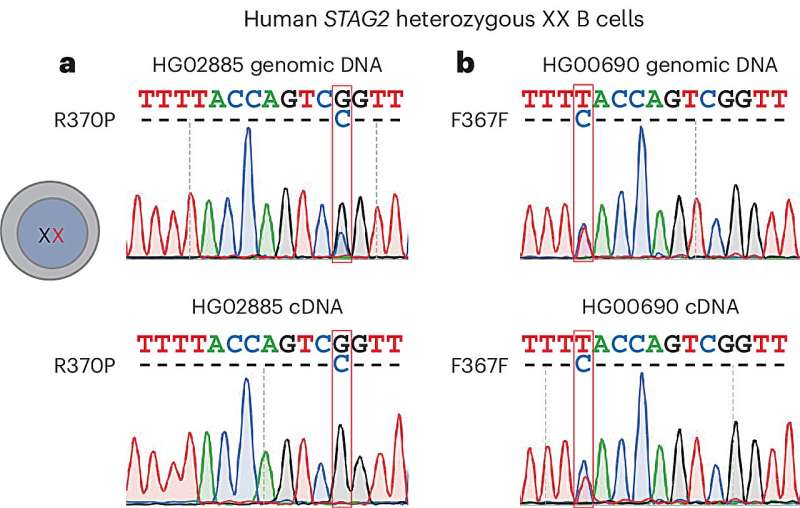This article has been reviewed according to Science X's editorial process and policies. Editors have highlighted the following attributes while ensuring the content's credibility:
fact-checked
proofread
Maternal and paternal X-chromosomes show skewed distribution in different organs and tissues

A study published in Nature Genetics by the Lymphoid Development Group at the MRC Laboratory of Medical Sciences reveals that the contribution of cells expressing maternal or paternal X chromosomes can be selectively skewed in different parts of the body.
The study leverages human data from the 1000 Genomes Project combined with mouse models of human X chromosome-linked DNA sequence variation to advance our fundamental understanding of development in biologically female individuals who have two X chromosomes.
Until now, it was thought that the usage of maternal and paternal X-chromosomes was similar throughout the body. The new work shows that this is not always true, and that different organs may be skewed towards using either maternal or paternal X-chromosomes.
The work also reveals the process driving this skew: competition between cells expressing either one or the other X-chromosome. In some individuals, cells in organs such as the heart mostly use the X chromosome from one parent, whereas immune cells almost exclusively utilize the X chromosome from the other parent. This provides an important step forward in understanding the underlying principles and mechanisms of development in XX individuals.
Biological females inherit two X chromosomes—one from each parent—along with all the other genetic material that builds and sustains the body. But despite the presence of both parental X chromosomes, only one X chromosome is actively expressed in any given cell.
Since the DNA sequence of each X chromosome has genetic variations, each cell effectively chooses to express a set of unique characteristics derived from either one or the other parent.
"We realized that when cells chose one of their two X chromosomes over the other, they also chose which set of genetic variants to express," said Matthias Merkenschlager, who leads the Lymphocyte Development Research Group.
"As a result, individual cells express distinct genetic variants. We are now working to find out more about how X-linked genetic variants shape organismal development, and whether selective X chromosome usage in specific tissues may affect the likelihood of certain conditions later in life."
The researchers focused on a specific gene on the X chromosome, called STAG2. They found that cells with a genetic variant of STAG2 failed to develop into immune cells called lymphocytes in females that carried variant STAG2 on one X chromosome, and the common ('reference') version of STAG2 on the other X chromosome.
By contrast, cells with the same variant of STAG2 were fully competent to form lymphocytes in XY males (with a single copy of the X chromosome), or females in which both X chromosomes carried the variant.
The researchers concluded that what prevents variant cells from forming lymphocytes is not the variant as such, but the presence of cells expressing the reference version of STAG2. This shows that cells compete for 'permission' to form specific cell types within the body.
The findings reveal a new aspect of X-linked diversity not previously appreciated: that interactions between cells can shape the contribution of X-linked diversity to specific cell types and tissues.
Even if cells expressing reference STAG2 outcompete to form the blood, cells expressing the variant may predominate in other parts of the body. For the study's lead author, Teresa Buenaventura, this sparked a personal curiosity. "Working on this project has been particularly exciting for me since it has made me curious about the contribution of each of the X chromosomes to my different tissues," she said.
These findings reveal a previously underappreciated aspect of X-linked diversity, where interactions between epigenetically diverse clones can shape the contribution of X-linked genetic diversity to specific cell types and tissues.
More information: Teresa Buenaventura et al, Competition shapes the landscape of X-chromosome-linked genetic diversity, Nature Genetics (2024). DOI: 10.1038/s41588-024-01840-5




















